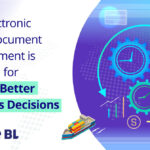The ongoing global transition towards trade digitalization is swiftly reshaping conventional practices, especially within trade finance. At the heart of this change lies the rise of electronic bills of lading (eBL) platforms, which are instrumental in facilitating the reliable exchange of not only eBLs but all kinds of Electronic Trade Documents (ETD), especially documents of a possessory nature.
This post will discuss how the global shift towards trade digitalization swiftly transforms traditional practices, particularly within trade finance. You’ll learn how electronic bills of lading (eBL) platforms are at the forefront of this transformation and pivotal in facilitating the reliable exchange of various Electronic Trade Documents (ETD), particularly those of a possessory nature.
Pivotal Role of Electronic Bills of Lading in Trade Digitalization
Electronic bills of lading (eBL) platforms are instrumental in the digitalization of trade finance, enabling the reliable exchange of various Electronic Trade Documents (ETD). Acting as legislated documentation of shipped cargo, eBLs serve as controlled instruments, ensuring exclusive possession by a single holder to maintain integrity and prevent unauthorized transfers.
These documents also function as collateral funded by banks in LC and collection transactions, instilling trust and providing assurance to all parties involved in shipping transactions.
Overall, eBL platforms play a crucial role in driving the digital transformation of trade finance, facilitating secure and efficient trade transactions while revolutionizing global commerce.
Challenges in Transitioning to eBL
Transitioning from paper-based bills of lading to electronic versions presents several challenges:
- Ensuring Exclusive Control: Establishing robust mechanisms to ensure only one holder maintains exclusive control over the original eBL.
- Facilitating Title Management: Managing the chain of signatures to enable lawful presentations and facilitate trade finance automation.
- Securing Data Authenticity: Implementing digital authentication methods and encryption protocols to prevent fraud.
- Facilitating Digital Identity Management: Establishing sound digital identity management systems to connect real-world companies and subunits to digital identities.
- Legal Framework: Navigating cross-jurisdictional legal challenges to ensure acceptance and validity of eBL.
- Connectivity and Integration: Deploying and managing widespread adoption, connectivity, and integration among stakeholders from all industries.
- Standard SaaS Concerns: Addressing data privacy, confidentiality, and liability concerns inherent in SaaS platforms.
The Evolution of eBL Platforms
Historically, attempts to create eBLs began with facsimile networks in the 1980s, later transitioning to internet-based platforms. However, the true game-changer came with blockchain technology, offering a decentralized ledger for trustless registries. Today, blockchain-based eBL platforms dominate the market, offering enhanced security and transparency.
The Role of Blockchain Technology
The introduction of blockchain technology has revolutionized eBL platforms, offering a decentralized ledger for trustless registries.
While public blockchains offer enhanced robustness, private blockchain options provide greater control and accountability. Behind every eBL platform lies a company responsible for any service defaults, emphasizing the importance of liability and risk management regarding utilizing the blockchain.
Standardization and Liability in eBL Platforms
Industry bodies like ICC, DCSA, and BIMCO are crucial in introducing standardized document structures and APIs for issuance. However, Trade digitization and agreeing on unified standards for each trade document are two different things that will easily catch up in the future and are not dependent on each other.
“For the global supply chain, fully interoperable eBL is a starting point for digital trade. It will make today’s practices more efficient, reliable and sustainable, but ultimately it will provide a foundation for further digitalisation,” commented Thomas Bagge, CEO of DCSA. “According to our year-end 2021 research, less than 1.2% of all bills of lading was electronic. We urge all industry stakeholders to get involved and be part of the movement to work towards 100% eBL adoption.”
Looking Ahead
As we navigate the future of eBL platforms, the focus remains on making eBLs more accessible by eliminating the need to pre-onboard the entire chain to the platform and enhancing cross-platform interoperability.
By addressing these challenges, eBL platforms will continue to drive the digital transformation of trade finance, revolutionizing global commerce as we know it. Join us and redefine efficiency in trade. www.wavebl.com
Join the Global Trade Finance Digitizing Revolution: Work Smarter with WaveBL
From eliminating paperwork bottlenecks to ensuring compliance and enhancing visibility, WaveBL offers innovative solutions to redefine trade finance for the digital age.
As Swift rightly puts it, “Electronic documents have the potential to make global trade more efficient, cheaper, and more secure.”
With WaveBL’s innovative solutions, businesses can embrace the future of global trade and experience unprecedented efficiency, accuracy, and competitiveness.
Stay tuned for more insights, success stories, and updates as we navigate the future of trade together.
WaveBL – Transforming Trade, Empowering Businesses. Your Gateway to Efficient Trade



